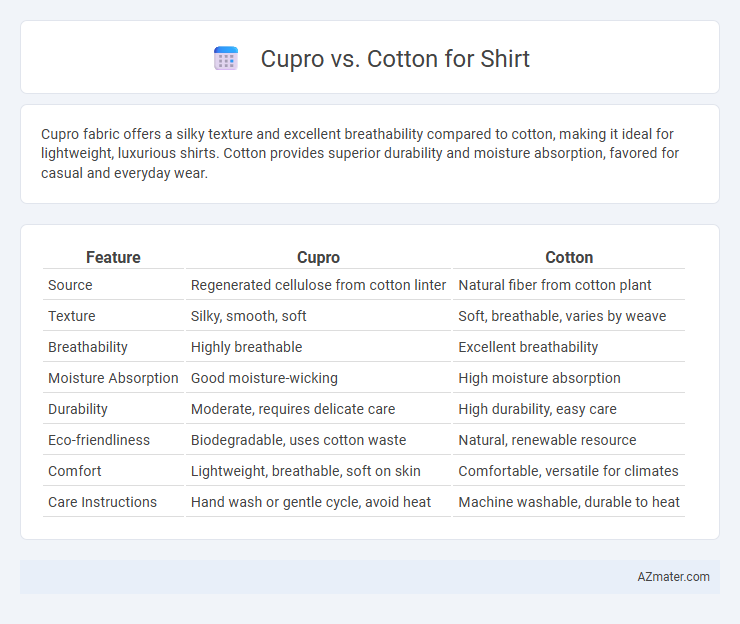Cupro fabric offers a silky texture and excellent breathability compared to cotton, making it ideal for lightweight, luxurious shirts. Cotton provides superior durability and moisture absorption, favored for casual and everyday wear.
Table of Comparison
| Feature | Cupro | Cotton |
|---|---|---|
| Source | Regenerated cellulose from cotton linter | Natural fiber from cotton plant |
| Texture | Silky, smooth, soft | Soft, breathable, varies by weave |
| Breathability | Highly breathable | Excellent breathability |
| Moisture Absorption | Good moisture-wicking | High moisture absorption |
| Durability | Moderate, requires delicate care | High durability, easy care |
| Eco-friendliness | Biodegradable, uses cotton waste | Natural, renewable resource |
| Comfort | Lightweight, breathable, soft on skin | Comfortable, versatile for climates |
| Care Instructions | Hand wash or gentle cycle, avoid heat | Machine washable, durable to heat |
Introduction: Understanding Cupro and Cotton
Cupro, a regenerated cellulose fiber derived from cotton linter, offers a silky texture and excellent breathability, making it a luxurious alternative to traditional cotton. Cotton, a natural fiber harvested from cotton plants, is renowned for its softness, durability, and moisture-wicking properties, widely used in shirt manufacturing. Understanding the fiber origin, texture, and environmental impact of Cupro and Cotton is essential for selecting the best fabric in terms of comfort and sustainability.
Cupro: Origins and Production Process
Cupro, derived from regenerated cellulose fibers extracted from cotton linter, is a sustainable fabric known for its silky texture and breathability. The production process involves dissolving cotton linter in a chemical solution to create a smooth, fine fiber that is then spun into fabric, offering a luxurious alternative to traditional cotton. Cupro's eco-friendly manufacturing contributes to reduced waste by utilizing cotton industry by-products, making it a favored choice in eco-conscious fashion.
Cotton: Overview and Manufacturing
Cotton, derived from the natural fibers of the cotton plant, is a highly breathable and absorbent material favored for shirt manufacturing due to its softness and durability. The cotton production process involves harvesting fibers, ginning, spinning into yarn, and weaving or knitting, resulting in versatile fabric types such as combed or organic cotton. Compared to Cupro, cotton offers superior moisture-wicking properties and easier maintenance, making it a preferred choice for everyday wear shirts.
Environmental Impact: Cupro vs Cotton
Cupro is a regenerated cellulose fiber made from cotton linter, offering a sustainable alternative by utilizing cotton waste that would otherwise be discarded, reducing landfill contributions. Cotton cultivation demands significant water, pesticides, and land resources, resulting in higher environmental strain compared to cupro's closed-loop production process, which recycles nearly all chemicals and water. The biodegradable nature of both fibers benefits end-of-life disposal, but cupro's eco-friendly manufacturing and resource efficiency provide a lower overall environmental footprint than conventional cotton.
Comfort and Breathability Compared
Cupro fabric offers superior moisture-wicking properties and a silky smooth texture, enhancing comfort in warm weather compared to cotton. Cotton shirts provide excellent breathability and softness, but tend to retain more moisture, making them less ideal for high humidity. Cupro's natural fabric structure allows better airflow, ensuring a cooler, more comfortable wear throughout the day.
Durability and Longevity of Fabrics
Cupro fabric, made from regenerated cellulose fibers derived from cotton linter, offers superior durability compared to traditional cotton due to its silk-like strength and resistance to wear and tear. Cotton shirts, while breathable and comfortable, tend to weaken over time with frequent washing and exposure to sunlight, making them less long-lasting than Cupro. The enhanced fiber structure of Cupro ensures that shirts maintain shape and texture longer, providing excellent longevity for intensive wardrobe use.
Aesthetic Qualities: Texture and Appearance
Cupro fabric offers a smooth, silky texture with a subtle sheen that enhances shirt aesthetics, providing a luxurious and elegant appearance. Cotton presents a softer, matte finish with a breathable structure, delivering a classic and casual look ideal for everyday wear. The choice between cupro and cotton depends on desired texture sophistication and the intended visual style of the shirt.
Care and Maintenance Requirements
Cupro shirts require gentle hand washing or dry cleaning to maintain fabric integrity and avoid shrinkage, with low heat ironing recommended to prevent damage. Cotton shirts are more durable and can withstand machine washing and higher ironing temperatures but may shrink if not pre-shrunk or washed improperly. Proper care for both fabrics ensures longevity, with cupro demanding more delicate handling compared to the more robust cotton.
Cost Comparison: Cupro vs Cotton Shirts
Cupro shirts generally cost more than cotton shirts due to the complex manufacturing process and sustainable production methods involved in cupro fabric. Cotton shirts are more affordable and widely available, benefiting from large-scale cultivation and established supply chains. Pricing for cupro shirts typically ranges from 20% to 50% higher than comparable cotton shirts, reflecting its premium status and eco-friendly appeal.
Choosing the Right Fabric: Final Considerations
Cupro offers a silky texture with excellent breathability and moisture-wicking properties, making it ideal for lightweight, luxurious shirts. Cotton provides durability, softness, and easy care, suited for everyday wear and higher abrasion resistance. When choosing the right fabric, consider factors like climate, desired comfort, maintenance, and environmental impact to match your lifestyle and fashion needs.

Infographic: Cupro vs Cotton for Shirt
 azmater.com
azmater.com